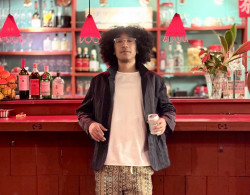
Originally published on metropolis.co.jp on August 2014
Metropolis met with dancer, artist and choreographer Rasta Thomas, the creator of Bad Boys of Dance, a hard-rockin’ multi-talented dance troupe based out of Takoma Park, Maryland. Thomas was in town to talk about his upcoming show, Rock the Ballet 2, a combination of ballet, contemporary dance and modern music.
From Punches to Pirouettes
Thomas’ father held a philosophy that all boys were innately bad, and without structure and regimentation they would get in trouble. And it seems he was right.
When Thomas was seven, his father decided he was being disrespectful to his martial arts teachers, and threatened to sign him up for ballet class as punishment. For a boy convinced that he’d grow up to be an action hero, Thomas was sure there was no way his father would follow through.
The next day, Thomas found himself in ballet class, without a tutu. And to everyone’s surprise—including his own—he was good. When the ballet instructor asked at the end of the class if he had learned his lesson about humility, Thomas offered a karate-solid “yes”—and was promptly offered a dancing scholarship. The rest, as they say, is history.
Enter the Bad Boys
Although Thomas continued to take dance lessons alongside his martial arts classes, it wasn’t until he discovered Michael Jackson and Gene Kelly, as well as martial arts god Bruce Lee and basketball pro Michael Jordan, that he began to get a sense of what it truly meant to move. It was this holistic realization that triggered his deeper interest in dance, and soon he began to research into the similarities between different kinds of movement.
The Bad Boys of Dance were formed in 2007, when Thomas was looking to step out of the conformist personal politics of traditional ballet. “I had been trained in different styles myself,” Thomas explains. “And I wanted a hub to train other guys in different styles and vocabularies, and also make it accessible to a younger generation. That was one of my major motivations. I performed in these wonderful ballet productions, and when I took the final bow, I saw so many older people—the one percenters that can afford to buy tickets. So I wondered how we could make it so that anyone could watch. I don’t want to discriminate—I want everyone to enjoy it.
“So I started thinking, if it’s your birthday, and you want to have fun and celebrate, you’re not going to play Tchaikovsky or Beethoven—whatever music you like—but more of today. And when you go up to guys and say you want to dance and look cool, you’re not going to wear tights. I think the music and costumes can take away the appeal for a younger audience. So we wear jeans and black pants and we dance to the music of today.
“I called [the group] Bad Boys because I never listened to authority. My father called me bad, my teachers called me bad, so I thought ‘Hmm, what should I call myself?’ and Bad Boys just came naturally. Especially since we’re trying to do things differently and separate ourselves from the classical style.”
Rocking the Tutu
The original concept for Rock the Ballet, the Bad Boys’ mainstay production, featured only male dancers. Thomas imagined a group of guys honing their craft to create an irresistible chemistry, not unlike the way boy bands and sports teams do worldwide.
However, after a few shows, he felt something was missing: they were dancing like friends and brothers, but there was no sense of rivalry. As a result, Thomas’ wife, Adrienne Canterna, was introduced to the mix as the main female dancer the men would fight over, creating chemistry and drama. This was no shot in the dark—a professional dancer and Tomas’ friend since childhood, Canterna was co-creator of the Bad Boys, and choreographer for both Rock the Ballet and Rock the Ballet 2.
Since Canterna’s introduction, the company has consisted of six men and one woman. While Thomas acknowledges the large, visually stunning corps of 15-40 dancers normally featured in a big ballet production, he intentionally keeps his own numbers low—and not just because they all sleep in his house and seven is as many as it can hold. Rather, he hopes to ensure that every member of his hard-working has a distinguishable character. “I think you should know who we are.” Thomas tells Metropolis. “The guy with the big muscles, or the guy that can turn and jump. So we stuck with the small group, and now everyone’s memorable.”
To ensure that an international audience would appreciate the show, he included hits by Queen, Michael Jackson and other global stars, arguing that while the tracks may not be everyone’s favorites, everyone will know the music and have emotions attached to the songs.
Rock the Ballet 2 also showcases local talent for its Japanese run. “We’re featuring an amazing local dancer called Yusuke Onuki, who is incredible,” Thomas says. “He’s really upping the stakes and pushing my boys hard. And it’ll be a great opportunity to show his fans a different style, and showcasing what he does best.”
And what is the show itself? “Act 1 is a love story,” Thomas explains. “Boy meets girl, loses girl, wins her back. Act 2 is more of a celebration of fun music. It’s not ballet, it’s not contemporary—more like a showcase of what everyone can do.”
Thomas is confident that the show will win audiences over, wherever he takes it: “If you haven’t seen a dance show yet this year, it should be the one,” he says. “And if you have seen one, this one will be better. Come to ours!”
Rock the Ballet 2 plays August 28-31 at Tokyo Metropolitan Theatre, with tickets ¥6.000-8,000.










